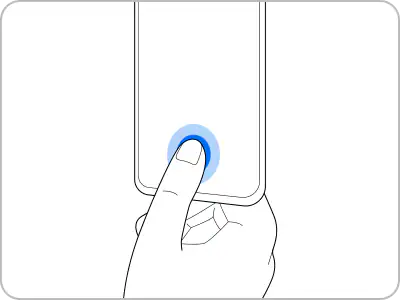Here’s the crux of the article in video form:
Google did a great job not providing any info on the performance improvements of the fingerprint sensor, if any, that Pixel 8 and Pixel 8 Pro buyers can expect following the problems that plagued Pixel 7 and Pixel 6 devices. Sure, the in-display fingerprint sensor hasn’t been Google’s strong point. But this doesn’t mean there haven’t been year-on-year improvements in general performance.
The Pixel 7 Pro, for instance, was a notch or two better than the Pixel 6 Pro, and so is the Pixel 8 Pro when pitted against last year’s model. However, for a $1,000 phone, there’s more Google could’ve done to up the experience to the level of Samsung Galaxy S23 or even the older Galaxy S22.

The Pixel 8 fingerprint sensor is great, but not perfect
Make no mistake. Glorious things have already been said about the Pixel 8 fingerprint sensor. Most early adopters agree the sensor represents significant performance improvements compared to the Pixel 6 and even last year’s Pixel 7. It works more reliably than ever, which is great for anyone looking to get the new phones. Google even went a step further and baked secure face unlock to make the phone more hacker resistant. Even with these forward leaps, the quality of Pixel 8 fingerprint and face unlock performance is still incomparable to Samsung Galaxy S23 and iPhone 15 Pro.
Samsung Galaxy S23’s ultrasonic fingerprint sensor is the best in the business. iPhone 15 Pro’s Face ID remains an industry leader. The Pixel 8 and 8 Pro, on the other hand, rely on the same optical fingerprint sensor as before, which pretty much suggests no major performance improvements from a hardware point of view. While the phone’s face unlock is Android’s highest biometric class, it still relies on software (AI) to convert a 2D image of your face into a 3D-like representation for secure authentication. This is unlike Apple’s Face ID, which relies on sophisticated hardware for the same purpose. Maybe not today or even tomorrow, but I get the feeling someone will manage to get past the Pixel 8 face unlock.
Less capable hardware could be the potential source of Pixel 8 fingerprint scanning problems
I had hoped for a switch to the more reliable ultrasonic sensor that Samsung has been using in its phones for a while now. But Google opted to cheap out once again with the weaker and less reliable optical sensor even on its pricier model. I’m not sure why the powers that be at Google thought having a temperature sensor was a genius idea when the fingerprint scanner is in dire need of hardware improvements.
![]()
A switch from an optical to an ultrasonic fingerprint sensor would’ve been a much-needed state of life improvement and better investment of the the money and resources used to add a temperature sensor on the Pixel 8 Pro. We are not in 2020, no one needs walking around with a thermometer, Google.
Google is into its third year using in-display scanning technology. I expect more at this point. For a phone that costs $1,000, the fingerprint performance quality you get on the Pixel 8 Pro could be much better. The growing concerns in the Google Pixel subreddit from people who can only get into their phones 50% of the time when using the fingerprint scanner shouldn’t be there if Google made the simple switch to the much more reliable ultrasonic sensor. But hopefully, this switch eventually comes, even if it means waiting another year until the Pixel 9 arrives.
Optical vs ultrasonic fingerprint sensors
At this point, you might be wondering what exactly are the advantages and disadvantages of optical and ultrasonic fingerprint scanners. Well, below is a simplified table of what you get with either technology.
| Feature | Optical sensor | Ultrasonic sensor |
| Technology | Captures fingerprint images using light and sensors | Uses ultrasound waves to create a 3D image of fingerprints |
| Fingerprint capture | 2D image of the fingerprint | 3D image of the fingerprint with depth information |
| Accuracy | Less accurate and can be affected by dirt, moisture (wet fingers), and scratches | More accurate and reliable, as it captures a 3D image of the fingerprint |
| Speed | Faster, but with lower accuracy | Slightly slower, but with better accuracy |
| Secure | Low (easy to fool due to 2D representation) | High (hard to fool due to 3D representation) |
| Environmental factors | Affected by things like moisture and lighting conditions | Less affected by moisture and lighting conditions |
| Implementation | Suitable for budget smartphones | Suitable for high-end smartphones for enhanced security |
| Cost | Cheap | Expensive |
Conclusion
As noted, a good number of people say it works, although you need clean hands. You’re out of luck with your dirty fingers, wet or dry fingers, or maybe even rough fingers due to the type of work you do. These types of issues aren’t a problem for the ultrasonic sensors. It can scan through damaged fingers to get accurate readings and unlock your phone without any problems, but the Pixel 8 tends to struggle.
![]()
Granted, using less capable hardware could be the potential source of fingerprint scanning problems affecting some Pixel 8 owners. However, this might be more noticeable for people coming from devices with superior fingerprint scanning hardware such as Samsung Galaxy S23, Galaxy S22 or even the older Galaxy S21.

